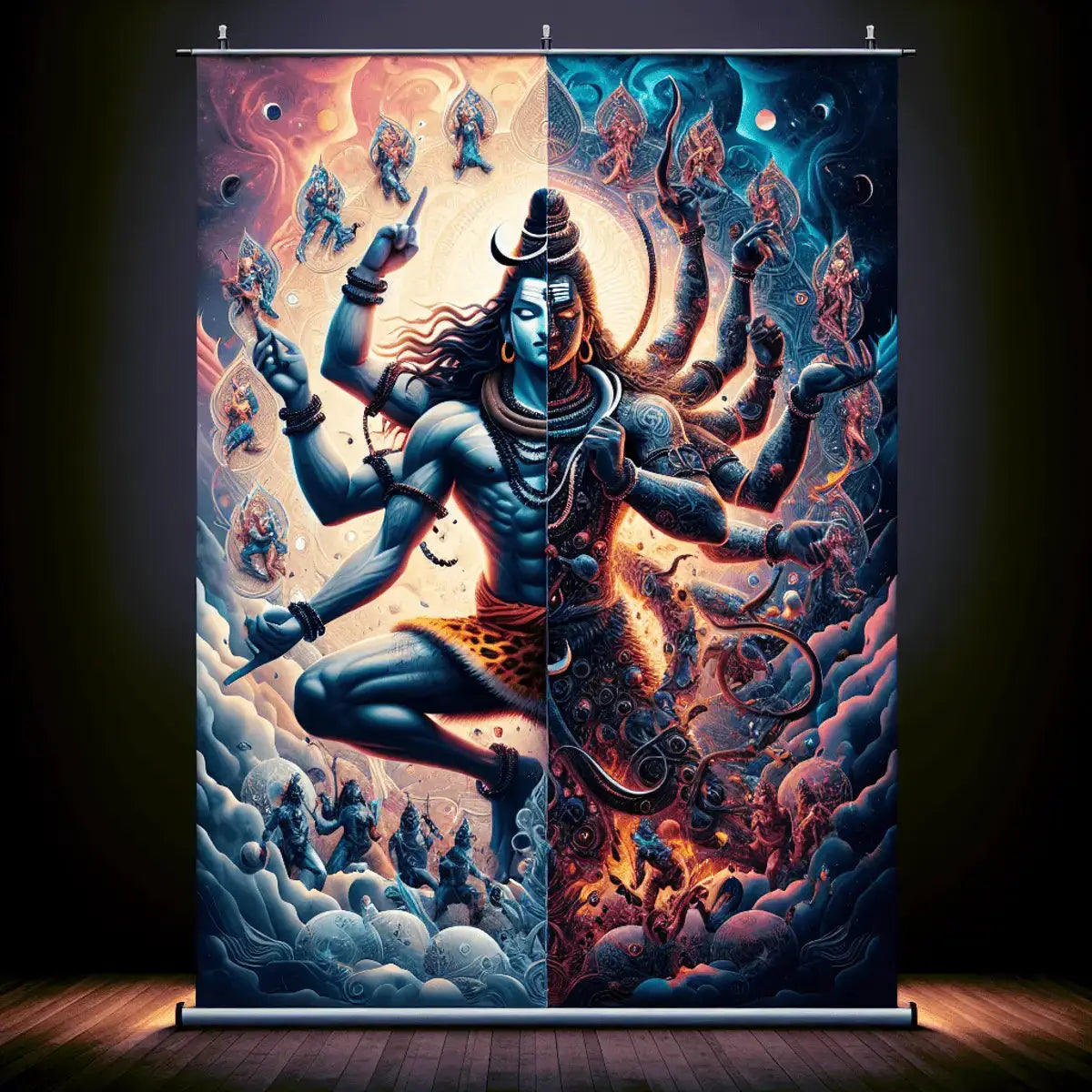Introduction
Shiva, a principal deity in Hinduism, represents both destruction and transformation. Also known as Mahadeva, he is commonly called the god of destruction, but his powers go beyond just destruction. This complexity emphasizes his role in the cycle of life.
The reverence for Shiv ji invites individuals to explore the balance of life and death, making him an enduring symbol of both chaos and harmony—Shiv Shakti. This duality is beautifully represented in art and culture, such as in the natraj backdrop cloth banner featuring dancing Shiva, which symbolizes not only his destructive aspect but also his role as a transformative force.
1. Understanding Shiva: His Role and Importance
Shiva is a key figure in the Hindu Trimurti, which includes Brahma (the creator), Vishnu (the preserver), and Shiva himself as the destroyer. In Shaivism, he is worshipped as the Supreme Being, representing the delicate balance between creation and destruction.
The Fascinating Dual Nature of Shiva
One interesting aspect of Shiva's character is his dual nature:
- Destroyer: Shiva's role in transformation highlights the necessity of destruction for regeneration.
- Transformer: This aspect emphasizes the power of rebirth and renewal.
This duality not only establishes Shiva as a powerful force but also signifies his importance in the ongoing cycle of life. Understanding this complexity enhances one's appreciation for his mystique and significance in Hindu philosophy. Such insights into Shiva's nature contribute to a deeper exploration of Shaivism and its teachings.
Artistic Expressions of Reverence for Shiva
The reverence for Shiva is often expressed through various forms of art and worship. For instance, a Nataraja statue symbolizes his cosmic dance that represents creation, preservation, and destruction. Similarly, a brass Shiva Lingam is often used in Hindu festive poojas, embodying his divine energy and presence.
2. Attributes and Symbolism of Shiva
Shiva's physical characteristics are rich in meaning, showcasing his divine nature:
- Blue Throat: This distinctive feature symbolizes his act of consuming poison during the churning of the ocean (Samudra Manthan). The poison, representing negativity and chaos, highlights Shiva's role as a protector who absorbs harm to ensure cosmic balance.
- Third Eye: Often depicted closed or open, this eye signifies heightened perception and wisdom. It embodies the ability to see beyond illusion, providing insight into the deeper truths of existence.
The representation of Shiva as Nataraja, the cosmic dancer, further emphasizes his duality in creation and destruction. This form illustrates the rhythm of life through dance, symbolizing the cyclical nature of the universe—creation through movement and dissolution through stillness.
Each attribute serves as a reminder of Shiva's profound connection to both spiritual and worldly realities.
3. Myths and Legends Surrounding Shiva
Shiva's rich mythology is filled with captivating stories that illustrate his pivotal role in the cosmic order.
1. Churning of the Ocean (Samudra Manthan)
This popular myth involves the deities and demons collaborating to churn the ocean for the nectar of immortality. During this process, Shiva consumes the deadly poison that emerges, turning his throat blue, a powerful symbol of his sacrifice for the welfare of all beings.
2. Pashupati
In lesser-known legends, Shiva takes on the form of Pashupati, the lord of animals. This avatar emphasizes his connection to nature and highlights his role as a protector and nurturer of all living creatures.
These narratives shape cultural understandings of destruction and regeneration, revealing how Shiva's actions lead to balance and harmony in the universe. Through these legends, devotees find inspiration in Shiva's dual nature as a fierce protector and a compassionate savior, reflecting life’s cyclical essence.
4. Family Dynamics in Shiva's Life
Shiva, known for his profound relationships, is deeply connected to his consorts and children.
1. Consorts
Parvati, his primary consort, embodies love and devotion. She plays a crucial role in balancing his fierce persona with compassion.
Durga and Kali represent different aspects of Shakti, highlighting the multifaceted nature of feminine energy in the universe.
2. Children
Ganesha, the beloved remover of obstacles, symbolizes intellect and new beginnings. His creation from Parvati's affection showcases parental love.

Skanda, the god of war, represents valor and courage. His narratives often reflect the protective instincts of Shiva as a father.
The dynamics within this divine family illustrate themes of love, balance, and strength. They present a rich tapestry of relationships that enhance our understanding of Lord Shiva's character and his role as a nurturing yet formidable force in Hindu mythology.
For those who wish to honor these divine figures in their homes, buying a brass Shiv Parivar idol statue can serve as a beautiful reminder of these sacred relationships. Additionally, during festive occasions like Maha Shivratri, one might consider using a Shiv puja kit to perform rituals that bring one closer to Lord Shiva.
Moreover, the Shiva Lingam, an important symbol in Hindu worship, can further enhance one's spiritual connection with the divine.
5. Worship Practices Associated with Shiva
Worshiping Shiva involves rich rituals that connect devotees to his divine essence. Central to these practices are Lingam offerings, which represent Shiva's transcendent nature. The Lingam, often depicted as a smooth cylindrical stone, symbolizes the infinite and formless aspects of the deity.
Common Worship Practices:
- Offerings: Devotees present items such as milk, honey, fruits, and flowers at Shiva temples, enhancing spiritual connection.
- Chanting Mantras: Reciting Om Namah Shivaya invokes Shiva's blessings. This powerful mantra is believed to cleanse the mind and spirit, fostering inner peace.
- Abhishekam: Ritual bathing of the Lingam with sacred substances like water or ghee signifies purification and reverence.
Engaging in these worship rituals nurtures devotion while reflecting a deep understanding of Shiva’s transformative energy. Such practices create an atmosphere of devotion and encourage a profound relationship between the devotee and the divine.
6. Festivals Celebrated in Honor of Shiva
Celebrations dedicated to Lord Shiva are vibrant, full of devotion and cultural significance. The most prominent festival, Maha Shivaratri, occurs annually in honor of Shiva. This night is believed to be when Shiva performed the cosmic dance of creation and destruction.
Key Rituals During Maha Shivaratri:
- Fasting: Devotees often observe a strict fast, abstaining from food and water to purify the mind and body.
- All-Night Vigil: Many participate in night-long prayers and chanting, focused on the mantra Om Namah Shivaya.
- Offerings: The lingam is adorned with flowers, fruits, and milk, symbolizing devotion and respect.
Shiva temples are bustling with activity as devotees gather to pay homage. The atmosphere is charged with spirituality, bringing together communities in shared reverence for this Supreme Being.
7. The Cosmic Dance and Philosophical Insights
Nataraja, as the embodiment of Lord Shiva's cosmic dance, symbolizes the interconnectedness of creation, preservation, and destruction. This dance represents the eternal cycles of existence, illustrating how life continuously transforms through rhythms of chaos and harmony.
Metaphor for Cosmic Cycles
Each movement reflects the dynamic interplay between opposing forces—creation and dissolution, joy and sorrow—creating a tapestry of existence.
Influence on Yoga and Meditation
Shiva’s teachings inform many yoga practices, emphasizing balance between action and stillness.
Meditation techniques inspired by Nataraja encourage practitioners to embrace life's transient nature, fostering a deep understanding of their inner selves.
Shiva's cosmic dance invites followers to engage with the universe's rhythm while cultivating spiritual awareness through mindful practices.
8. Shiva in Art and Culture
Classical Artistic Representations
- Iconic Bronze Sculptures: Ancient artisans crafted intricate Nataraja bronzes during the Chola dynasty, showcasing precise details of Shiva's cosmic dance
- Temple Architecture: Sacred structures feature elaborate stone carvings depicting Shiva's various forms, particularly in:
- Elephanta Caves
- Kailasa Temple at Ellora
- Brihadeshwara Temple
Literary Traditions
- Sanskrit Literature: Shiva Purana presents elaborate narratives of Shiva's divine acts
- Abhijnanasakuntalam by Kalidasa references Shiva's celestial marriage
- Regional Poetry: Tamil Bhakti poems by Nayanars celebrate Shiva's grace
- Medieval mystic poets composed devotional verses in vernacular languages
Contemporary Interpretations
- Digital Art: Modern artists reimagine Shiva through 3D renderings and graphic novels incorporating Shiva's mythology in new narratives
- Popular Culture: Film adaptations exploring Shaivite themes and contemporary music integrating traditional Shiva stotras with modern compositions
Symbolic Elements in Artwork
- Distinctive Attributes: Trishul (trident) representing three gunas, crescent moon symbolizing wisdom, and third eye depicting spiritual knowledge
Traditional artistic guidelines (shilpa shastras) continue to influence modern depictions while allowing creative interpretations
Global Cultural Impact
- Museum exhibitions worldwide showcasing Shaivite art
- Cross-cultural artistic collaborations incorporating Shiva imagery
- Integration of Shiva symbolism in world music and dance performances
9. Shiva's Multifaceted Roles and Divine Aspects
Shiva is a complex deity with various roles and aspects that reflect different cosmic principles. Here are some of the key roles and divine aspects of Shiva:
The Destroyer in the Trimurti
Shiva is known as the Destroyer in the Trimurti, which consists of Brahma (Creator), Vishnu (Preserver), and Shiva (Destroyer). His role as the Destroyer is not about destruction in a negative sense but rather as a necessary force in the cosmic cycle. Here are some of the functions of Shiva as the Destroyer:
- Functions as the essential force of dissolution in the cosmic cycle
- Brings necessary endings for new beginnings
- Works in harmony with Brahma (Creator) and Vishnu (Preserver)
- Represents the transformative power of consciousness
The Great Ascetic (Mahayogi)
Shiva is often depicted as a great ascetic or yogi who embodies perfect meditation and spiritual discipline. Here are some characteristics of Shiva as the Great Ascetic:
- Embodies perfect meditation and spiritual discipline
- Resides in Mount Kailash in deep contemplation
- Demonstrates mastery over:
- Physical desires
- Mental fluctuations
- Worldly attachments
- Serves as the original guru of yoga traditions
The Lord of Dance (Nataraja)
In his form as Nataraja, Shiva is portrayed performing a cosmic dance known as Tandava. This dance represents various cosmic processes such as creation, preservation, destruction, concealment, and revelation. Each gesture of Nataraja carries profound symbolic meaning:
- Raised foot: Liberation
- Drum: Primordial sound
- Fire: Purification
- Supporting foot: Maya (illusion)

Ardhanarishvara: The Divine Union
Ardhanarishvara is a unique form of Shiva that represents the synthesis of masculine and feminine energies. Physically depicted as half male (Shiva) and half female (Parvati), this form symbolizes non-dualistic philosophy, perfect balance of opposites, inseparability of Shiva and Shakti, and teaches the principle of unity in diversity.
Additional Divine Forms
Apart from these prominent forms, Shiva also manifests in various other divine forms, each representing specific qualities:
- Dakshinamurthy: The supreme teacher
- Bhairava: The fierce protector
- Lingamurthy: The formless absolute
- Chandrasekhara: Lord adorned with moon
Conclusion: Embracing the Powers of Shiva in Modern Spirituality
Understanding Lord Shiva opens doors to enriching spiritual practices today. His teachings inspire:
- Emotional Resilience: Learning to embrace destruction as a precursor to transformation.
- Mindfulness: Engaging with meditation and yoga rooted in Shiva’s philosophies.
Exploring Shaivism offers deeper insights into the profound layers of existence. Delving into this ancient tradition enhances connections with oneself and the universe, providing wisdom that resonates across time. Embrace the essence of Shiva, allowing his powers to guide your spiritual journey towards enlightenment and balance.





















1 comment
Interesting from inert side